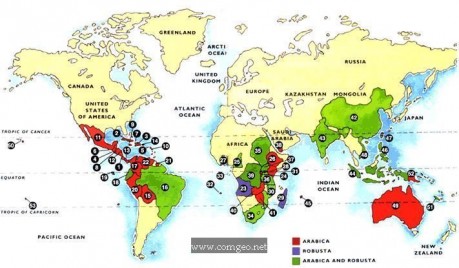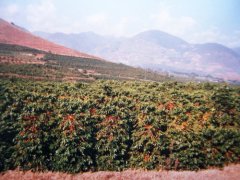Coffee flavors from different coffee producing areas around the world
Costa Rican coffee has full granules, ideal acidity and unique strong flavor.
Tarrazu in Costa Rica is one of the major coffee producing areas in the world. The coffee produced is light and pure in flavor and pleasant in aroma. Costa Rica, with its fertile volcanic soil and good drainage, is the first country in Central America to grow coffee and bananas for commercial value. Coffee and bananas are the country's main exports. Coffee was introduced into Costa Rica from Cuba in 1729 and today its coffee industry is one of the most well-organized industries in the world with a yield of 1700 kg per hectare. Costa Rica, with a population of only 3.5 million, has 400 million coffee trees, and coffee exports account for 25 per cent of the country's total exports. Costa Rica has also benefited from the establishment of the Central American Institute for Agricultural Research (Turrialba of the Central American Agricultural Research Institute, referred to as IAAC) in Tarasu, which is an important international research centre.
High-quality Costa Rican coffee is called "extra hard beans". This kind of coffee can grow above 1500 meters above sea level. Altitude has always been a problem for coffee growers. The higher the altitude, the better the coffee beans, not only because the higher altitude can increase the acidity of the coffee beans and thus increase the flavor, but also because the night temperature at the higher altitude is lower, which can make the trees grow slowly, thus making the coffee beans have a stronger flavor. In addition, due to the high altitude drop caused by sufficient rainfall, is also very beneficial to the growth of coffee trees. However, while there are many advantages to growing coffee at higher elevations, the resulting additional transport costs must be taken into account, which is likely to make coffee production unprofitable. The coffee industry in Costa Rica has adopted new technologies to increase efficiency, including the use of "electric eyes" to select beans and identify coffee beans of irregular size.
Located in the south of the country's capital, San Jos é, Tarasu is one of the most valued coffee growers in the country. La Minita Tarrazu coffee is a famous local product, but its production is limited, about 72600 kilograms a year. It is grown on a piece of land called La Minita, which is owned by the last three generations of the McAlpine family in the UK. In fact, this land can produce more than 450 tons of coffee a year. But Tarasu Latin America coffee is grown without artificial fertilizers or insecticides, and its harvesting and selection are done by hand, in order to avoid some damage to coffee beans caused by air spray selection.
Other coffees worth mentioning are Juan Vinas,PR, H.Tournon, Windmill,SHB, Monte bello and Ssnta Rosa. Fine coffee is generally grown in Geredia and the central canyon. Another striking type of coffee is Sarchi (one of the five towns that represent Costa Rica's Coffee Road), which grows on the slopes of the Poas Volcano volcano, 53km from San Jose. Saatchi, founded in 1949, has a land area of 30770 hectares and grows sugar cane and coffee. The area is also famous for its handicrafts, attracting tourists from all over the world.
The country's coffee industry, originally controlled by the Costa Rican coffee industry company Instituto del Caf é de Costa Rica (ICAFE), has been taken over by the official Coffee Committee (Oficina del Caf é). Among the exported coffee, those products that are considered to be of substandard quality are colored with blue vegetable dyes and then transferred back to China for sale. Coffee consumed domestically (dyed blue or undyed) accounts for about 10% of total production, and local per capita coffee consumption is twice that of Italy or the United States.
Attached: 53 coffee producing areas and maps around the world

1. Costa Rica Costa Rica
2. Cuba Cuba
3. Dominican Republic Dominican Republic
4. Ei Salvador El Salvador
5. Guadeloupe Guadeloupe
6. Guatemala Guatemala
7. Haiti Haiti
8. Honduras Honduras
9. Jamaica Jamaica
10. Martinique Martinique
11. Mexico Mexico
12. Nicaragua Nicaragua
13. Panama Panama
14. Puerto Rico Puerto Rico
15. Bolivia Bolivia
16. Brazil Brazil
17. Colombia Colombia
18. Ecuador Ecuador
19. Galapagos Islands Galapagos Islands 20. Peru Peru
21. Surinam Suriname
twenty-two。 Venezuela Venezuela
23. Angola Angola
24. Burundi Burundi
25. Cameroon Emaelon
twenty-six。 Ethiopia Ethiopia
twenty-seven。 Coted'Ivoire C ô te d'Ivoire
twenty-eight。 Kenya Kenya
twenty-nine。 Madagascar Madagascar
thirty。 Mozambique Mozambique
thirty-one。 Rwanda Rwanda
thirty-two。 St.Helena St. Helena
thirty-three。 Sao Tome and Principe Sao Tome and Principe
thirty-four。 South africa South Africa
thirty-five。 Sudan Sudan
thirty-six。 Tanzania Tanzania
thirty-seven。 Uganda Uganda
thirty-eight。 Yemen Yemen 39. Zaire Zaire
forty。 Zmbia Zambia
forty-one。 Zimbabwe Zimbabwe
forty-two。 China China
forty-three。 India India
forty-four。 Indonesia Indonesia
forty-five。 La Reunion Reunion
forty-six。 Philipines Philippines
forty-seven。 Taiwan Taiwan of China
forty-eight。 Vietnaam Vietnam
forty-nine。 Australia Australia
fifty。 Hawail Hawaii
fifty-one。 New Caledonia, New Aridonia
fifty-two。 Papua New Guinea Papua New Guinea
fifty-three。 Taihiti Tahiti
Important Notice :
前街咖啡 FrontStreet Coffee has moved to new addredd:
FrontStreet Coffee Address: 315,Donghua East Road,GuangZhou
Tel:020 38364473
- Prev

Overview of Jamaica Blue Mountain Coffee Producing Area
Almost everyone who has heard of Jamaica Blue Mountain coffee knows it is the most expensive coffee in the world. But not everyone knows why. Like Rolls-Royce cars and Stradivarius violins, when something gains the best reputation in the world, that reputation
- Next

Yunnan Lujiang Coffee Farm is located in the west of Yunnan Province.
Lujiang Farm is located in the west of Yunnan Province, 24952515 north latitude and 98839888 east longitude. The altitude is 6801000 meters. Under the jurisdiction of Longyang District, Baoshan City, adjacent to Lujiang Town and Mangkuan Dai and Yi Township, 542km east to Kunming, capital of Yunnan Province, 120km west to Myanmar Banwa, highway through farm to Kunming, national secondary highway directly to Myitkyina of Myanmar, transportation is very convenient, air
Related
- Does Rose Summer choose Blue, Green or Red? Detailed explanation of Rose Summer Coffee plots and Classification in Panamanian Jade Manor
- What is the difference between the origin, producing area, processing plant, cooperative and manor of coffee beans?
- How fine does the espresso powder fit? how to grind the espresso?
- Sca coffee roasting degree color card coffee roasting degree 8 roasting color values what do you mean?
- The practice of lattes: how to make lattes at home
- Introduction to Indonesian Fine Coffee beans-- Java Coffee producing area of Indonesian Arabica Coffee
- How much will the flavor of light and medium roasted rose summer be expressed? What baking level is rose summer suitable for?
- Introduction to the characteristics of washing, sun-drying or wet-planing coffee commonly used in Mantenin, Indonesia
- Price characteristics of Arabica Coffee Bean Starbucks introduction to Manning Coffee Bean Taste producing area Variety Manor
- What is the authentic Yega flavor? What are the flavor characteristics of the really excellent Yejasuffi coffee beans?

